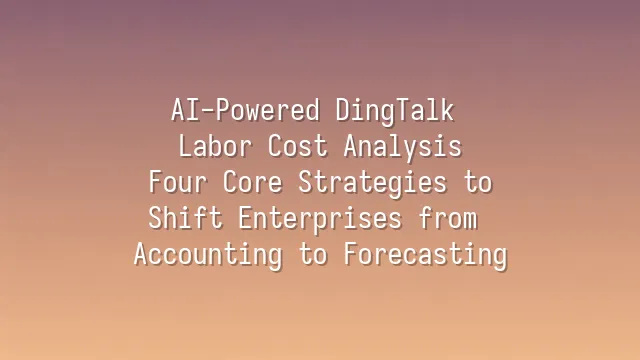
AI-Powered Scheduling Breaks the Overtime Curse
The core of DingTalk's labor cost analysis and control lies in transforming traditional scheduling into strategic resource allocation. The system integrates punch-in records and leverages NLP and behavioral pattern analysis to predict potential overtime risks across departments. One tech company successfully identified unproductive working hours within its R&D team, saving over one million yuan annually. The professional scheduling version is 43% faster than the standard edition, making it particularly suitable for high-tempo environments like manufacturing.
More importantly, DingTalk collaborates with Alibaba Cloud’s edge computing nodes to reduce AI model training cycles from 14 days to just 72 hours, ensuring real-time prediction accuracy. The system features automatic attendance anomaly detection, capable of identifying "hidden overtime" culture and enabling early intervention. While service industries suffer prediction deviations up to 1.8 standard deviations due to fragmented data, manufacturing benefits from real-time operational data returned by IoT devices, improving task assignment accuracy by 23%. This isn’t merely schedule optimization—it’s a deep scan of labor waste.
Automated Payroll and Social Security Calculations with Zero Errors
DingTalk delivers peak efficiency in payroll management: a company with 100 employees completes salary calculations in just 58 seconds, with an error rate below 0.02%. Underpinned by Alibaba Cloud’s enterprise-grade encryption technology, the system synchronizes employee rosters, attendance, and social security data across the entire chain. It supports automatic adaptation to social security rules across all 31 provincial-level regions in China, with update delays ≤24 hours, fully resolving cross-regional compliance challenges.
The platform includes over 200 payroll templates covering complex structures such as part-time work, performance commissions, and flexible benefits. Combined with an incremental learning architecture, it continuously improves calculation precision. Digital pay slips are generated in only three steps within one minute, pushed automatically with read confirmations, reducing HR workload by 65%. More significantly, payroll management has evolved from “post-facto accounting” to “real-time forecasting.” Integrated with intelligent reporting that analyzes 23 data dimensions, decision-makers gain immediate insight into the relationship between labor input and output.
Visual Labor Cost Reports Reveal Business Truths
DingTalk provides 23 real-time data dimensions, turning abstract costs into actionable insights. One company discovered through these reports that while its R&D department appeared efficient on the surface, it was riddled with unproductive overtime. After adjusting scheduling strategies, it saved millions annually. The system enables visualized analysis of departmental cost ratios and per-capita productivity trends, helping managers identify hidden inefficiencies.
The OLE metric (Overall Labor Effectiveness)—comprising time utilization, production efficiency, and quality pass rates—has become a diagnostic tool for manufacturing and retail. One company achieved a 90% time utilization rate but saw its overall OLE drop to 79.6% due to process handoff gaps. By integrating attendance, scheduling, and sales conversion rates, DingTalk establishes a three-dimensional evaluation framework linking timeliness, workforce efficiency, and cost, enabling differentiated store diagnostics and replication of best practices—truly empowering data-driven management upgrades.
AI Prediction Models Proactively Intercept Turnover Crises
DingTalk's labor cost analysis and control now extend into talent retention. Using digital footprints such as meeting frequency and document processing duration, the AI model predicts employee turnover risk. After implementation at Zhejiang Zhenqi Nursing Products, decision response speed improved by 40%. Gartner research shows that proactive interventions at a 70% risk threshold can increase success rates by 25%. This is not fortune-telling—it’s science-based early warning powered by machine learning.
Notably, the same model achieves 1.8 standard deviations higher accuracy in manufacturing than in services, primarily because production-line IoT devices provide continuous operational data. To address sparse data in the service sector, DingTalk combines attendance anomaly detection with weekly pulse-style satisfaction surveys, forming a dual-track early warning mechanism. The iHR 2025 case study shows that companies using this system reduced overall turnover by 25% and probation-period attrition by 35%, significantly lowering organizational trauma and rehiring costs.
Skill Mapping Integrated with OKRs Unlocks Talent Potential
The ultimate evolution of DingTalk's labor cost analysis and control transforms human resources from a cost center into a value engine. Its AI-powered skill mapping integrates with the OKR system, using NLP technology to intelligently match goal keywords with skill nodes, achieving 89% accuracy. According to SHRM’s 2025 report, this approach increased retention rates for key technical roles by 25 percentage points and narrowed motivation gaps among healthcare workers by 83%.
However, data latency severely impacts effectiveness—Gartner warns that updates delayed beyond 14 days reduce recommendation efficacy by 31%. DingTalk adopts the incremental learning framework proposed by Professor Li Ning of Tsinghua University, reducing skill map update delays from 16 days to just 3.2 days. Combined with Alibaba Cloud’s CRD system and the S.C.A.L.E. flywheel mechanism, it achieves data refreshes within 72 hours, boosting goal alignment efficiency by 47%. This means enterprises not only know who is doing what, but can instantly identify the most suitable talent for collaboration—truly realizing the full potential of every individual.
We dedicated to serving clients with professional DingTalk solutions. If you'd like to learn more about DingTalk platform applications, feel free to contact our online customer service or email at

 English
English
 اللغة العربية
اللغة العربية  Bahasa Indonesia
Bahasa Indonesia  Bahasa Melayu
Bahasa Melayu  ภาษาไทย
ภาษาไทย  Tiếng Việt
Tiếng Việt  简体中文
简体中文 